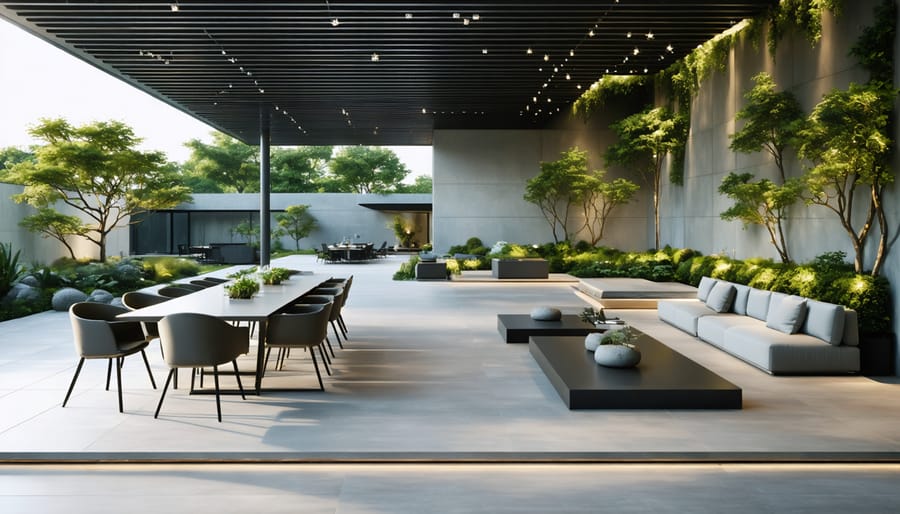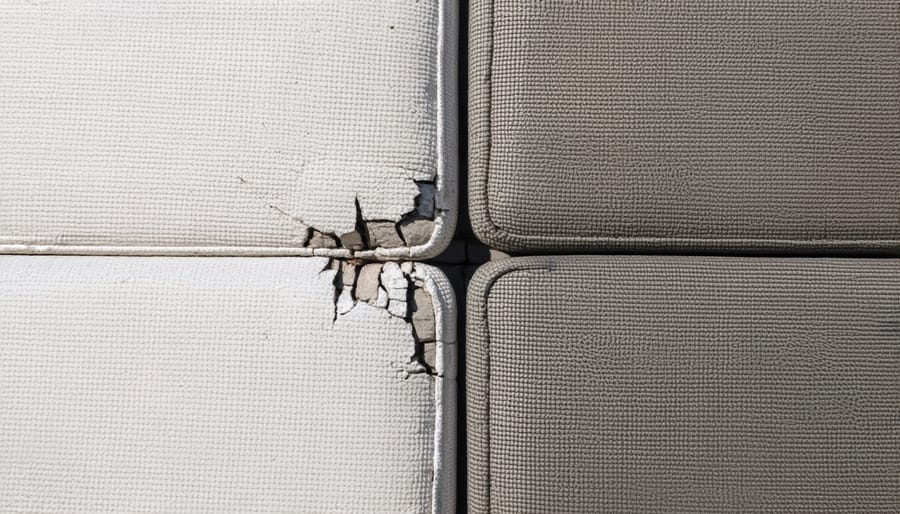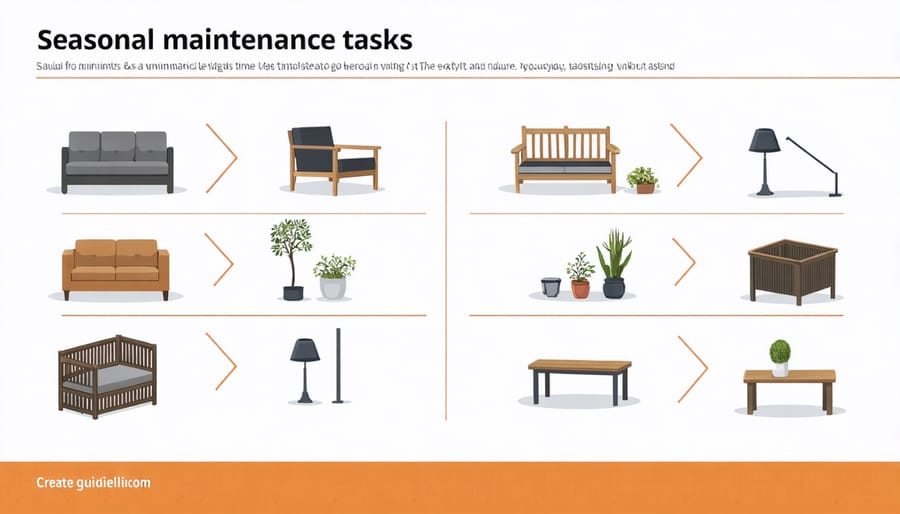These Weather-Resistant Materials Keep Your Outdoor Workspace Looking New for Years

Transform your professional outdoor workspace with weather-resistant materials engineered to withstand nature’s harshest elements. Marine-grade stainless steel and powder-coated aluminum frames offer superior rust resistance while maintaining structural integrity through extreme temperature fluctuations. High-density polyethylene (HDPE) and solution-dyed acrylic fabrics deliver fade-resistant, waterproof performance that stands up to intense UV exposure and heavy rainfall. Performance-grade teak and modified wood composites provide natural beauty with minimal maintenance, requiring only occasional cleaning to maintain their original appearance.
These commercial-quality materials have revolutionized outdoor furniture design, combining durability with sophisticated aesthetics that complement any exterior setting. Modern manufacturing techniques ensure these materials retain their integrity for 10+ years while requiring minimal upkeep – making them ideal investments for long-term outdoor use. Whether facing coastal salt spray, desert heat, or winter freeze cycles, these materials maintain their structural stability and visual appeal across all seasons.

Top-Performing Materials That Stand Up to Mother Nature
Powder-Coated Aluminum: The Lightweight Champion
When it comes to ergonomic outdoor furniture design, powder-coated aluminum stands out as an exceptional choice. This lightweight material offers remarkable durability without the burden of heavy lifting, making it perfect for frequently moved pieces. The powder coating process creates a protective layer that resists rust, corrosion, and UV damage, ensuring your furniture maintains its appearance through various weather conditions.
Maintenance is refreshingly simple – regular cleaning with mild soap and water is usually sufficient. Unlike other metals, aluminum won’t rust or deteriorate in wet conditions, and its natural resistance to coastal air makes it ideal for seaside locations. The material’s strength-to-weight ratio means you can enjoy sturdy furniture that’s easy to rearrange for different outdoor setups without sacrificing durability or style.
Marine-Grade Stainless Steel: Built for Coastal Conditions
Marine-grade stainless steel stands out as a top choice for coastal areas where salt air and moisture pose significant challenges. This remarkable material contains higher levels of chromium and nickel than standard stainless steel, creating an invisible protective layer that actively resists corrosion. Perfect for outdoor furniture frames and hardware, it maintains its sleek appearance even after years of exposure to harsh seaside conditions.
What makes it truly special is its self-healing property – if the surface gets scratched, the protective layer naturally regenerates. For coastal homeowners, this means less maintenance and longer-lasting furniture. While it may cost more initially, marine-grade stainless steel proves its value through exceptional durability and minimal upkeep requirements. Just an occasional wash with mild soap and water keeps it looking pristine, making it an ideal investment for long-term outdoor use.
High-Density Polyethylene (HDPE): The All-Weather Solution
HDPE has become a favorite among outdoor furniture enthusiasts, and for good reason. This robust material stands up remarkably well to harsh weather conditions, from scorching sun to freezing temperatures. Unlike traditional materials, HDPE won’t crack, peel, or fade, even after years of exposure to intense UV rays. Its non-porous surface naturally resists moisture, preventing the growth of mold and mildew that typically plagues outdoor furniture.
Maintenance couldn’t be easier – a simple wipe-down with soap and water is all it takes to keep HDPE furniture looking fresh. The material’s color runs throughout, meaning scratches are less noticeable, and it never needs painting or refinishing. Plus, HDPE furniture is surprisingly comfortable, as it doesn’t get as hot in the sun as metal alternatives, making it perfect for year-round use in your outdoor workspace.
Weather Protection Features That Matter
UV Protection and Fade Resistance
When it comes to protecting outdoor furniture from harsh sunlight, UV resistance is crucial for maintaining both appearance and durability. Different materials handle sun exposure in varying ways, with some offering natural protection while others require additional treatments.
Synthetic materials like high-quality polyethylene and HDPE plastics contain UV inhibitors that prevent color fading and material breakdown. These materials typically maintain their appearance for 5-10 years with minimal maintenance. Marine-grade fabrics such as Sunbrella offer exceptional UV protection and are specially designed to resist fading, making them perfect for cushions and upholstery.
Natural materials like teak contain oils that provide inherent UV protection, though they will naturally weather to a silvery-gray patina over time. Cedar and other hardwoods can be protected with UV-resistant sealers, which should be reapplied every 1-2 years for optimal protection.
For metal furniture, powder-coated finishes provide excellent UV resistance and prevent color fading. Aluminum naturally resists UV damage, while wrought iron requires regular maintenance with UV-protective paint to prevent rust and deterioration.

Moisture and Rust Prevention
Modern moisture and rust prevention technologies have revolutionized outdoor furniture protection. Powder coating stands out as a leading treatment, creating a tough barrier that prevents water from reaching the metal surface. This process involves electrostatically applying dry powder to furniture, which is then heated to form a durable, moisture-resistant shield.
Many manufacturers now incorporate sacrificial anodes into their metal furniture designs, similar to those used in marine equipment. These zinc-based components corrode first, protecting the main structure from rust formation. Additionally, UV-stabilized sealants and water-repelling nano-coatings provide invisible yet effective protection against moisture intrusion.
For wooden furniture, pressure treatment with copper-based preservatives offers excellent water resistance. Modern variations are eco-friendly while maintaining effectiveness. Manufacturers also use specialized oils and resins that penetrate deep into the wood’s fibers, creating a natural water barrier without changing the material’s appearance.
Regular maintenance with water-resistant waxes or sprays can enhance these built-in protections, ensuring your outdoor furniture stays beautiful and functional for years to come.
Temperature Fluctuation Tolerance
Temperature fluctuations can put significant stress on outdoor furniture materials, making their ability to withstand these changes crucial for longevity. High-quality polyresin wicker and powder-coated aluminum excel in this aspect, showing minimal expansion or contraction between extreme temperatures. Teak and other hardwoods naturally adapt to temperature changes, though they may develop small cracks that typically don’t compromise structural integrity. Marine-grade stainless steel and treated wrought iron maintain their strength across temperature ranges, while modern plastics are engineered with UV stabilizers and thermal resistance properties. For best results, choose materials rated for your climate zone’s temperature range, particularly if you experience frequent freeze-thaw cycles or intense summer heat.
Maintenance Tips for Long-Lasting Outdoor Furniture

Seasonal Care Routines
To maintain your outdoor furniture’s longevity, follow these seasonal care routines that complement your weather-proofing solutions. In spring, start with a thorough cleaning using mild soap and water to remove winter debris. Inspect for any damage caused by cold weather and tighten loose screws or fittings. Apply a fresh coat of protective sealant if needed.
During summer, regularly dust and wipe down furniture surfaces to prevent dirt buildup. Keep cushions in shade when possible and store them indoors during heavy rain. Consider using furniture covers during extended periods of intense sun exposure.
Fall maintenance focuses on preparing for winter. Clean thoroughly and check for rust spots or wear. Apply rust inhibitors to metal furniture and wood sealants to wooden pieces. Remove any fallen leaves promptly to prevent moisture retention and staining.
For winter, either store furniture indoors or use heavy-duty covers designed for harsh weather. If keeping items outside, elevate them slightly off the ground to prevent frost damage. Remember to occasionally brush off snow accumulation to prevent weight stress on furniture frames.
Monthly inspections throughout the year will help catch potential issues early, ensuring your outdoor furniture stays beautiful and functional for years to come.
Quick Fixes and Protection Methods
When faced with weather-related issues, there are several quick and effective solutions you can implement to protect your outdoor furniture. For minor water damage, thoroughly dry the affected area and apply a waterproof sealant specifically designed for your furniture’s material. This creates an additional barrier against moisture and can prevent further damage.
If you notice signs of rust on metal furniture, sand the affected area gently and apply a rust converter followed by rust-resistant paint. For wooden furniture showing early signs of rot, remove the affected portion and fill it with wood hardener and epoxy filler before refinishing.
UV damage can be addressed by applying a UV-protective spray or coating to your furniture. These products are particularly effective for plastic and wooden pieces that tend to fade or become brittle in direct sunlight.
To prevent future weather-related issues, consider using furniture covers when your outdoor pieces aren’t in use. Add rubber or plastic feet to raise furniture slightly off the ground, preventing water absorption from below. Regular cleaning with appropriate cleaners and immediate attention to any damage will significantly extend your furniture’s lifespan.
For fabric elements, treat them with fabric protector spray seasonally, and store cushions indoors during severe weather conditions.
Making the Smart Investment
When it comes to weather-resistant outdoor furniture, the initial investment might seem steep, but considering the long-term benefits makes it a smart financial decision. Quality weather-resistant materials typically cost 20-40% more than standard options, but they can last three to five times longer, making them more cost-effective over time.
Consider the hidden costs of cheaper alternatives: frequent replacements, regular maintenance, and potential damage to stored items. A well-made piece using weather-resistant materials might cost $200-300 more upfront but could save you $600-900 in replacement costs over its lifetime.
To maximize your investment, focus on high-traffic areas and pieces that see the most weather exposure. For example, investing in weather-resistant seating and table surfaces makes more sense than spending extra on decorative elements that receive less wear and tear.
Look for manufacturers offering extended warranties on weather-resistant furniture – this often indicates confidence in their product’s durability. Many quality pieces come with 5-10 year warranties, providing added peace of mind for your investment.
Remember that proper maintenance, though minimal with weather-resistant materials, still plays a crucial role in protecting your investment. Simple acts like seasonal cleaning and proper winter storage can extend the life of your furniture even further, maximizing your return on investment.
Choosing the right weather-resistant materials for your outdoor furniture is crucial for enjoying your outdoor space worry-free. From robust powder-coated aluminum and weather-treated teak to high-performance synthetic wicker and marine-grade stainless steel, each material offers unique benefits for different climates and preferences. Remember to consider your local weather patterns, maintenance commitment, and aesthetic goals when making your selection. For best results, combine quality materials with proper care routines, including seasonal cleaning and appropriate storage during extreme weather. By investing in weather-resistant furniture and following the maintenance guidelines we’ve discussed, you’ll create a lasting outdoor sanctuary that remains beautiful and functional for years to come. Whether you’re furnishing a cozy patio or a complete outdoor living room, these durable materials will help you make the most of your outdoor space.

